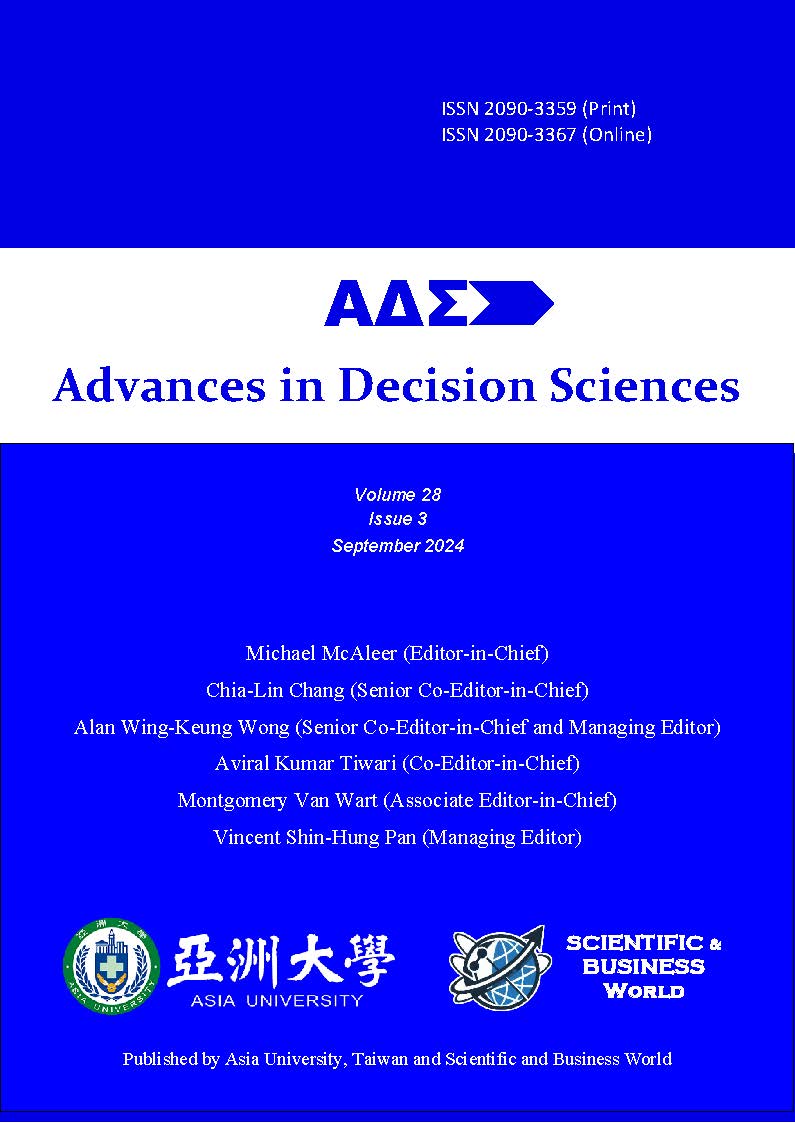Mitigating Financial Crimes: How Anti-Money Laundering Mechanisms Shape Bank Outcomes
DOI:
https://doi.org/10.47654/v28y2024i3p79-105Keywords:
Anti-Money Laundering, Bank Performance, Financial Crime, JordanAbstract
Purpose: This study examines the influence of anti-money laundering (AML) mechanisms on the financial performance of Jordanian banks, alongside assessing how macroeconomic and financial factors—such as inflation, GDP, bank size, quick ratio, and financial leverage—affect performance dynamics.
Design/methodology/approach: Using a descriptive-analytical approach, the research analyzes data from 12 Jordanian banks listed on the Amman Stock Exchange (ASE) from 2007 to 2021. Given the unbalanced nature of the panel data, fixed-effect models were employed to evaluate the relationship between AML indices, key bank performance metrics, and broader economic variables.
Findings: The results demonstrate a significant negative relationship between AML intensity and bank performance, indicating that stringent AML enforcement can impose short-term financial burdens. In contrast, liquidity (as measured by the quick ratio) and bank size positively and significantly impact profitability. Inflation was also found to significantly increase bank performance. Meanwhile, financial leverage displayed a negative but statistically insignificant influence on performance. These findings collectively illustrate the complex interplay between compliance obligations, operational characteristics, and macroeconomic conditions in shaping bank outcomes.
Research limitations/implications: The study focuses exclusively on Jordanian banks, and caution is advised when generalizing the findings to banks operating under different regulatory frameworks or economic systems.
Practical implications: The findings suggest that banks must carefully balance regulatory compliance costs with operational resilience strategies. Policymakers should consider frameworks that support banking sector stability without imposing excessive burdens on institutions, particularly smaller banks.
Social implications: Effective AML measures not only protect financial institutions but also foster public trust and contribute to the overall health of the financial system.
Originality/value: This paper provides comprehensive empirical insights into the intertwined effects of AML compliance and macro-financial factors on banking sector performance within an emerging market context.
References
Abdalla Abu Olaim, A. M., & Rahman, A. A. (2016). Recent development of anti-money laundering law in Jordan. Journal of Money Laundering Control, 19(4), 316-328.
Abu Olaim, A. M. A., & A. Rahman, A. (2016). The impact of Jordanian anti-money laundering laws on banks. Journal of Money Laundering Control, 19(1), 70-78.
Al-Manaseer, M., Al-Hindawi, R. M., Al-Dahiyat, M. A., & Sartawi, I. I. (2012). The impact of corporate governance on the performance of Jordanian banks. European Journal of Scientific Research, 67(3), 349-359.
Alnasser Mohammed, S. A. S. (2021). Money laundering in selected emerging economies: is there a role for banks? Journal of Money Laundering Control, 24(1), 102-110.
Al Qudah, A. M., Al-haddad, L., & Aljabali, A. A. (2025). Combatting medical corruption: A global review of root causes, consequences, and evidence-based interventions. International Journal of Innovative Research and Scientific Studies, 8(2), 968-985.
Altunbaş, Y., Thornton, J., & Uymaz, Y. (2021). Money laundering and bank risk: Evidence from US banks. International Journal of Finance & Economics, 26(4), 4879-4894.
Aluko, A., & Bagheri, M. (2012). The impact of money laundering on economic and financial stability and on political development in developing countries: The case of Nigeria. Journal of Money Laundering Control, 15(4), 442-457.
Arrow, K. J., Dasgupta, P., Goulder, L. H., Mumford, K. J., & Oleson, K. (2012). Sustainability and the measurement of wealth. Environment and development economics, 17(3), 317-353.
Barro, R. J. (1996). Democracy and growth. Journal of economic growth, 1, 1-27.
Beekarry, N. (2011). International anti-money laundering and combating the financing of terrorism regulatory strategy: a critical analysis of compliance determinants in international law. Nw. J. Int'l L. & Bus., 31, 137.
Birindelli, G., Ferretti, P., & La Torre, M. (2014). Anti-Money Laundering in Italian Banks. British Jorunal of Economics, Management & Trade, 4(6), 841-861.
Cheng, Y., Hui, Y., McAleer, M., & Wong, W. K. (2021). Spurious relationships for nearly non-stationary series. Journal of Risk and Financial Management, 14(8), 366.
Cohen, M. A., Fenn, S., & Naimon, J. S. (1995). Environmental and financial performance: are they related? Citeseer.
Condosta, L. (2012). How banks are supporting local economies facing the current financial crisis: An Italian perspective. International Journal of Bank Marketing.
Cotoc, C.-N. B., Șcheau, M. C., & Achim, M. V. (2020). Anti Money Laundering Effectiveness from a Legal Framework Perspective in Romania and European Countries. RSEP CONFERENCES.
Esoimeme, E. (2016). Balancing Anti-Money Laundering/Counter-Terrorist Financing Requirements and Financial Inclusion for Migrants: A Case Study of Germany. Counter-Terrorist Financing Requirements and Financial Inclusion for Migrants: A Case Study of Germany (January 2, 2016).
Guidara, A. (2022). CRYPTOCURRENCY AND MONEY LAUNDERING: A LITERATURE REVIEW.
Hopton, D. (2009). Money laundering: a concise guide for all business. Gower Publishing, Ltd.
Idowu, A., & Obasan, K. A. (2012). Anti-money laundering policy and its effects on bank performance in Nigeria. Business Intelligence Journal, 6(3), 367-373.
Ingves, S. (2014). Banking on leverage. keynote address to the 10th Asia-Pacific High-Level Meeting on Banking Supervision, Auckland, New Zealand.
Jarrow, R. A. (2014). Financial crises and economic growth. The Quarterly Review of Economics and Finance, 54(2), 194-207.
Jewell, J. J., & Mankin, J. A. (2011). What is your ROA? An investigation of the many formulas for calculating return on assets. Academy of Educational Leadership Journal, 15, 79-91.
Kemal, M. U. (2014). Anti-money laundering regulations and its effectiveness. Journal of Money Laundering Control, 17(4), 416-427.
Khan, W. A., Jawaid, S. T., & Arif, I. (2018). Where does a nation’s wealth go? Evidence from a third world country. Journal of Money Laundering Control.
Köster, H., & Pelster, M. (2017). Financial penalties and bank performance. Journal of Banking & Finance, 79, 57-73.
Le Khac, N. A., Markos, S., O’neill, M., Brabazon, A., & Kechadi, M. T. (2009). An investigation into data mining approaches for anti money laundering. In Proceedings of international conference on computer engineering and applications (ICCEA 2009) (pp. 504-508).
Levi, M., & Reuter, P. (2011). Money laundering.
Meles, A., Porzio, C., Sampagnaro, G., & Verdoliva, V. (2016). The impact of the intellectual capital efficiency on commercial banks performance: Evidence from the US. Journal of Multinational Financial Management, 36, 64-74.
Naheem, M. A. (2015). Trade based money laundering: towards a working definition for the banking sector. Journal of Money Laundering Control, 18(4), 513-524.
Naik, R. R., Stringer, S. J., Agarwal, G., Jones, S. E., & Stone, M. O. (2002). Biomimetic synthesis and patterning of silver nanoparticles. Nature materials, 1(3), 169-172.
Nance, M. T. (2018). The regime that FATF built: an introduction to the Financial Action Task Force. Crime, Law and Social Change, 69, 109-129.
Oulahan, R., & Lambert, W. (1967). The scandal in the Bahamas. Life, 62(5), 58-74.
Prendi, L., Borakaj, D., & Prendi, K. (2023). THE NEW MONEY LAUNDERING MACHINE THROUGH CRYPTOCURRENCY: CURRENT AND FUTURE PUBLIC GOVERNANCE CHALLENGES.
Shbeilat, M. K., & Alqatamin, R. M. (2022). Challenges and forward-looking roles of forensic accounting in combating money laundering: Evidence from the developing market. Journal of Governance and Regulation/Volume, 11(3).
Sonsuphap, R. (2022). The structure of the illegal economy and its relationship to money laundering. Corporate & Business Strategy Review, 3(1), 45-54.
Stessens, G. (2000). Money laundering: a new international law enforcement model (Vol. 15). Cambridge University Press.
Truby, J. (2016). Measuring Qatar’s compliance with international standards on money laundering and countering the financing of terrorism. Journal of Money Laundering Control, 19(3), 264-277.
Vaithilingam, S., & Nair, M. (2007). Factors affecting money laundering: lesson for developing countries. Journal of Money Laundering Control, 10(3), 352-366.
Villányi, B. (2021). Money Laundering: History, Regulations, and Techniques. In Oxford Research Encyclopedia of Criminology and Criminal Justice.
Wijaya, D. P., & Sedana, I. B. P. (2020). Effects of quick ratio, return on assets and exchange rates on stock returns. Am. J. Humanities Soc. Sci. Res, 4, 323-329.
Wong, W. K., & Pham, M. T. (2025). Could the correlation of a stationary series with a non-stationary series obtain meaningful outcomes?. Annals of Financial Economics, forthcoming.
Wong, W. K., & Yue, M. (2024). Could regressing a stationary series on a non-stationary series obtain meaningful outcomes?. Annals of Financial Economics, forthcoming.
Zutter, C. J., & Smart, S. B. (2019). Principles of managerial finance. Pearson London.

Published
Issue
Section
License
Copyright (c) 2024 Advances in Decision Sciences

This work is licensed under a Creative Commons Attribution-NonCommercial 4.0 International License.



 Scientific and Business World
Scientific and Business World